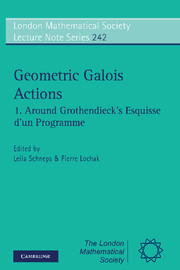Book contents
- Frontmatter
- Contents
- Preface
- ESQUISSE D'UN PROGRAMME
- Esquisse d'un Programme
- Brief an G. Faltings
- Grothendieck's “Long March through Galois theory”
- The algebraic fundamental group
- Etale homotopy type of the moduli spaces of algebraic curves
- The ‘obvious’ part of Belyi's theorem and Riemann surfaces with many automorphisms
- Glimpses of Grothendieck's anabelian geometry
- Some illustrative examples for anabelian geometry in high dimensions
- The fundamental groups at infinity of the moduli spaces of curves
- Galois representations in the profinite Teichmüller modular groups
- Deux lettres sur la cohomologie non abélienne
- The Grothendieck-Teichmüller group GT: a survey
- Approximating Galois orbits of dessins
- Tame and stratified objects
- Sketch of a Programme (translation into English)
- Letter to G. Faltings (translation into English)
The fundamental groups at infinity of the moduli spaces of curves
Published online by Cambridge University Press: 05 April 2013
- Frontmatter
- Contents
- Preface
- ESQUISSE D'UN PROGRAMME
- Esquisse d'un Programme
- Brief an G. Faltings
- Grothendieck's “Long March through Galois theory”
- The algebraic fundamental group
- Etale homotopy type of the moduli spaces of algebraic curves
- The ‘obvious’ part of Belyi's theorem and Riemann surfaces with many automorphisms
- Glimpses of Grothendieck's anabelian geometry
- Some illustrative examples for anabelian geometry in high dimensions
- The fundamental groups at infinity of the moduli spaces of curves
- Galois representations in the profinite Teichmüller modular groups
- Deux lettres sur la cohomologie non abélienne
- The Grothendieck-Teichmüller group GT: a survey
- Approximating Galois orbits of dessins
- Tame and stratified objects
- Sketch of a Programme (translation into English)
- Letter to G. Faltings (translation into English)
Summary
Abstract In this note we explicit and prove some assertions contained in the Esquisse, concerning the fundamental groups “at infinity” (see precise definitions below) of the fine moduli spaces of non singular pointed curves over the complex numbers. This is achieved essentially by connecting these assertions to some known results, obtained by topological methods. We also discuss related assertions for the coarse moduli spaces.
Introduction
We shall here be mainly concerned with one page (p.7) of the Esquisse, dealing with the fundamental group of the moduli spaces of pointed curves in an analytic context (i.e. over ℂ). Let us first quote the key sentence (starting at the bottom of p.6): “Ce principe de construction de la tour de Teichmüller n'est pas démontré à l'heure actuelle – mais je n'ai aucun doute qu'il ne soit valable. Il résulterait […] d'une propriété extrêmement plausible des multiplicités modulaires ouvertes Mg,v, dans le contexte analytique complexe, à savoir que pour une dimension modulaire N ≥ 3, le groupe fondamental de Mg,v (i.e. le groupe de Teichmüller habituel Tg,v) est isomorphe au ‘groupe fondamental à l'infini’ i.e. celui d'un ‘voisinage tubulaire de l'infini’”.
Let us first recall a few standard definitions and introduce some notation (which differs slightly from Grothendieck's). But first a warning to algebraic-geometers; here we shall actually be concerned only with the analytic part of the theory (“la théorie transcendante” as Grothendieck puts it on p.7 of the Esquisse), and indeed mostly with topological or at most real analytic properties.
Information
- Type
- Chapter
- Information
- Geometric Galois Actions , pp. 139 - 158Publisher: Cambridge University PressPrint publication year: 1997
Accessibility standard: Unknown
Why this information is here
This section outlines the accessibility features of this content - including support for screen readers, full keyboard navigation and high-contrast display options. This may not be relevant for you.Accessibility Information
- 1
- Cited by
